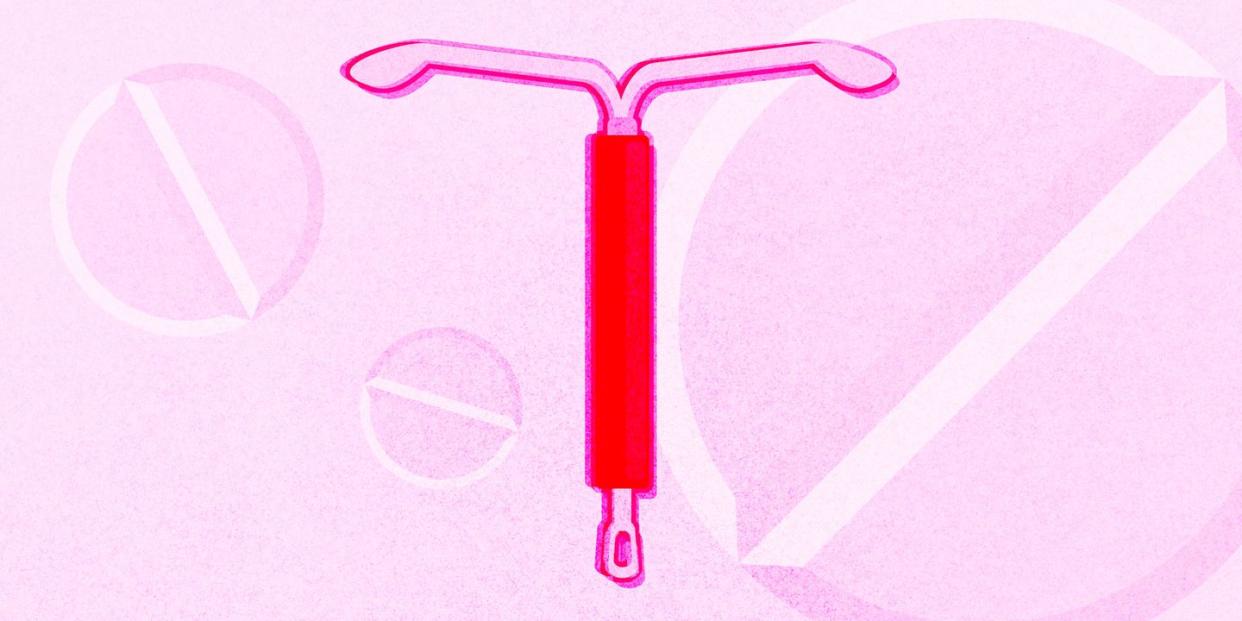Why Some Women Are Given Valium for IUD Insertion

The Mirena IUD is effective for five years, but Erin Jackson left hers in for six and a half. She was so scared of repeating the pain she felt when she had the contraceptive device inserted, she kept putting off the appointment to replace it.
"I almost passed out, it was so painful," Jackson, who's 33, says. She remembers the first insertion in excruciating detail- feeling like her gynecologist "jammed" the IUD through her cervix, and her boyfriend hovering over her face to try and keep her calm while her body quaked on the table.

But the only thing Jackson remembers about her second IUD placement is the anesthesiologist asking her to count backwards, and waking up in the recovery room a few minutes later. When Jackson, who has a chronic pelvic pain disorder, told her pelvic pain specialist she was scared of having her IUD replaced, he offered to do it for her at a nearby hospital under full, IV sedation.
Had Jackson known there was a way to have her IUD replaced without the pain, she wouldn't have put it off-and risked unintended pregnancy-for so long. But how could she have known? The first physician who placed her IUD when she was 24 knew about Jackson's pelvic pain disorder, too. The only difference between an insertion that left Jackson feeling traumatized, and one in which she felt nothing, was her physician.
the one thing I have learned from my time on this planet is if you have not had a kid and you get an IUD don't listen to your ob-gyn when they say you don't need Valium for the insertion
- Nicole Cliffe (@Nicole_Cliffe) May 21, 2018
Jackson says the pain was worth it to have a birth control method so highly recommended by gynecologists. So did many of the women who replied to a May 2018 tweet from writer Nicole Cliffe about requesting Valium for IUD insertions. An outpouring of women tweeted that they were dismayed to learn they could've had something stronger to help them get through their own painful insertions, if they'd only known they could ask.
Jackson was lucky because she didn't have to. But not everyone gets that lucky, because the clinical research surrounding IUD insertion pain doesn't line up with women's lived experiences.

Depending on who you ask, IUD insertion either feels like a regular period cramp, or like "blinding agony." Part of the process involves slightly dilating a woman's cervix to slip the IUD into place, which can cause extreme discomfort. Though a majority of women err on the side of period cramp, about 17 percent of nulliparous women, or women who haven't had a vaginal birth, experience "severe pain" that warrants prevention or relief.
Even though pain probably won't be an issue for most people, fear of pain is so high it's considered a barrier to getting an IUD, according to a 2015 Cochrane study. Which, considering the IUD's high level of effectiveness and safety, is a problem.
Providers and scientists are trying to figure out how to fix it. Currently, there's not a set protocol for pain management during IUD placement. That lack of a protocol has created a patchwork standard of care for a contraceptive method that's highly recommended by most gynecologists.
Dr. Eve Espey, chair of the American College of Obstetricians and Gynecologists' long-acting reversible contraception program, explained that every health care provider has their own protocol based on what they feel is best for their patient, and what's available in their clinic.

For some providers, that means prescribing medication for pain and anxiety. For others, it means offering local anesthetic, conscious sedation, or full IV sedation, AKA general anesthesia. And for Espey, who practices in two different clinics in New Mexico, her own protocol comes down to where she is that day.
"I work in two different clinics: one where it's very easy to get those medications, and one where it's not impossible, but it's like an act of Congress to get a medication," Espey says. "I offer [medication] in the one, and I don't in the other."
Some of the medications physicians offer include prescription medications like Valium and Ativan for anxiety (some studies suggest anxiety can cause muscle contractions, worsening pain); hydrocodone, tramadol, naproxen, or Tylenol-3 for pain; and misoprostol to soften the cervix. There's also documented use of local anesthetic injections to numb the cervix (called a paracervical block), nitrous oxide for conscious sedation, and full IV sedation, like Jackson had.
One of the reasons not all doctors offer these medications is that none of them have been yet been proven to significantly reduce discomfort (except general anesthesia that makes you fully unconscious). Clinical studies show that tramadol, naproxen, and 400-800 milligrams of ibuprofen don't prevent IUD placement pain. As of January 2017, the American Academy of Family Physicians officially recommends against the use of misoprostol to soften the cervix in healthy, nulliparous women, because it doesn't seem to help with procedure discomfort and increases post-insertion cramping. Clinical studies of nitrous oxide don't even show a measurable difference.
Espey says the only option that shows promise for easing IUD placement discomfort is the paracervical block, but still, that "usually involves injecting somewhere between 10 and 20 ccs of lidocaine into the cervix" and comes with "its own discomfort."
The most common pain management for IUD placement is "verbacaine"-the simple act of talking someone through the procedure, or distracting them by talking about other things (it's also commonly used in post-abortion counseling to mitigate discomfort).

Espey's personal IUD placement protocol involves verbacaine and "informed consent," or explaining the insertion process, what the IUD's side effects are, and what any potential complications may be. She's still trying to figure out how to best prepare patients for pain they may or may not feel.
"We know that if you talk to patients about pain, they tend to experience more," Espey says. "On the other hand, we have to be honest about the fact that this is an uncomfortable procedure. Some patients have vey little discomfort, and some patients have more. I say it's like a bad menstrual cramp with a sick feeling. I check in afterwards and say, did I describe that accurately?"
Espey's protocol used to include telling a patient to take ibuprofen beforehand, but she doesn't do that much anymore. "We used to all give ibuprofen," she says. "We were all pretty disappointed when the randomized control trial showed that it didn't work."

Even without the scientific backing, knowing the options exist matters. There's a gap between what the science says is true and what women say is true about IUD insertion pain management. Like so many other issues within women's health-the now-known link between depression and hormonal birth control, to name one-the anecdotal evidence and scientific evidence aren't lining up.
After two painful attempts to have a Mirena IUD placed at her gynecologist's office, Kristen Hubby, 23, was prescribed hyrdocodone and told to take it about 30 minutes before a third insertion attempt, scheduled a week later. "[The first two times], my whole body was shaking," Hubby says. "The third time was totally fine."
Like Jackson, Emily Smith*, 29, says her pain level was a 10 out of 10 when she had her first Mirena IUD inserted. When hormonal complications arose, she knew she needed to switch to the non-hormonal, copper IUD. Terrified of gritting her teeth through another excruciating procedure, she took a one milligram pill of Ativan she had at home to calm her nerves before the replacement (Smith's doctor didn't offer it).
"I knew I wouldn't go through with it if I didn't have some sort of anti-anxiety medication in my system, because I knew how much it was going to hurt," Smith says. "It was still pretty excruciating, but [the Ativan] helped me relax and focus on the pain less."
Women like Hubby and Smith are why Espey will generally give a patient medication if they ask for it. "Anecdotally, many of us-if we have access in our clinics to either a narcotic or an anti-anxiety medication like Ativan-will give it," Espey says.
Physicians like Espey-good physicians-aren't unconcerned with women's pain. But with IUDs, as with any form of contraception, access will always be the top priority. Espey's spent her whole career advocating for better IUD access. "I'm just so happy that it's available," she says. "I didn't think that we would be where we're at during my professional lifetime."
If there's a perfect medication that could make IUD insertion comfortable for everyone, Espey says it doesn't exist yet. But maybe that's another thing that could change within her professional lifetime.
*Name has been changed.

Follow Hannah on Twitter.
You Might Also Like


